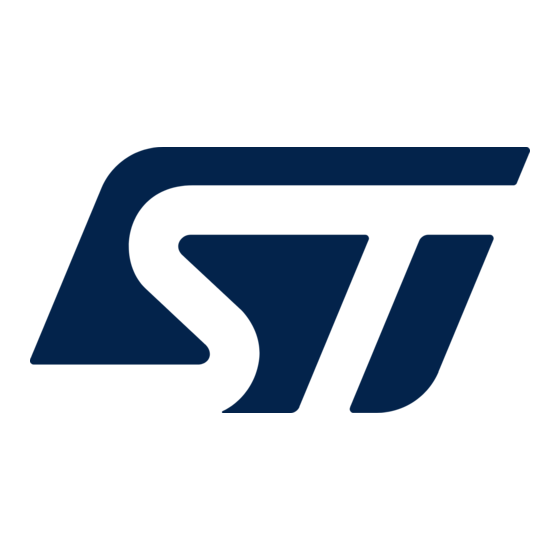
Summary of Contents for STMicroelectronics ST7-EPB
- Page 1 STMicroelectronics ST7-EPB Programming board UM0028 User manual Rev 4 June 2006 www.st.com...
- Page 2 BLANK...
- Page 3 ST7-EPB Programming board Introduction Thanks for choosing ST7! This manual will help you setup and start using your ST7-EPB programming board. ST7-EPB programming boards allow you to program ST7 microcontrollers that have EPROM, EEPROM and FLASH memories. Your programming board links, via parallel port, to a host PC running ST7 Visual Programmer (STVP7) software.
- Page 4 Introduction ST7-EPB About the user manuals... This manual will help you setup your ST7-EPB programming board and connect it to your PC. Here, you will find: ■ Setup instructions ■ Information about in-circuit programming connections For information about the hardware and software intended for use with your programming board, refer to the following documents that are included with it: ■...
-
Page 5: Table Of Contents
Setting up your ST7-EPB ........ -
Page 6: Getting Started
ST7-EPBs come in several types, which support the programming of different families of ST7 and package types. The sockets and connectors on your programming board will vary depending on the type of ST7-EPB you have ordered, and may not correspond exactly to the version shown here. 6/15... -
Page 7: Setting Up Your St7-Epb
Parts delivered with ST7-EPBs (not to scale) Optional Setting up your ST7-EPB To setup your ST7-EPB programming board: Shut down and power-off the host PC. Connect one end of the supplied parallel cable to the EPB’s P1 connector and the other end to one of the host PC’s parallel ports (LPT1 or LPT2). -
Page 8: Using An In-Circuit Programming Connection
Using an in-circuit programming connection Some ST7-EPB programmers allow in-circuit programming (ICP) of supported ST7 Flash microcontrollers, thanks to the In-Circuit Communication (ICC) protocol developed for ST7. This section provides information to help you setup your application HE-10 type connector board for in-circuit programming of your ST7. - Page 9 ICC mode unintentionally during a reset. Isolation of the RESET pin During an ICC session, your ST7-EPB must control the ST7’s RESET pin. No external reset can be generated by the application. This can lead to a conflict if the application reset circuitry signal exceeds 5mA (push-pull output or pull-up resistor <1k).
-
Page 10: Additional Information About Programming In Isp Mode
This connection allows you to start your ICP session using the ICP OPT Disable programming mode. In this mode, your ST7-EPB provides a clock source to initiate communication with the ST7 at a frequency of 16MHz. -
Page 11: Hardware Features
ST7-EPB 2 Hardware Features Hardware Features Parallel port connection The ST7 EPB communicates with your host PC (running STVP7) via a parallel port connection. Most communication failures between the host PC running STVP7 and your programming board stem from problems in the parallel port connection. -
Page 12: Appendix A Revision History
Appendix A Revision history ST7-EPB Appendix A Revision history Date Revision Changes • Transferred to user manual format November-2000 • Added new programmers • Added information about programming in ICP mode 18-June-2001 • Removed list of programmers • Transferred software installation and use information to STVP7 on-line help. -
Page 13: Appendix B Safety Requirements
ST7-EPB Appendix B Safety Requirements Appendix B Safety Requirements ● Any tester, equipment, or tool used at any production step, or for any manipulation of semiconductor devices, must have its shield connected to ground. ● The product must be placed on a conductive table top, made of steel or clean aluminum , or covered by an antistatic surface (superficial resistivity equal to or higher than 0.5... -
Page 14: Appendix C Product Support
Product Support If you experience any problems with this product, or if you need spare parts or repairs, contact the distributor or the STMicroelectronics sales office where you purchased the product. Phone numbers for major sales regions are provided in the Contact List , below. - Page 15 Please Read Carefully: Information in this document is provided solely in connection with ST products. STMicroelectronics NV and its subsidiaries (“ST”) reserve the right to make changes, corrections, modifications or improvements, to this document, and the products and services described herein at any time, without notice.
- Page 16 Mouser Electronics Authorized Distributor Click to View Pricing, Inventory, Delivery & Lifecycle Information: STMicroelectronics ST7MDT2-EPB2/US ST7MDT1-EPB2/US...




Need help?
Do you have a question about the ST7-EPB and is the answer not in the manual?
Questions and answers